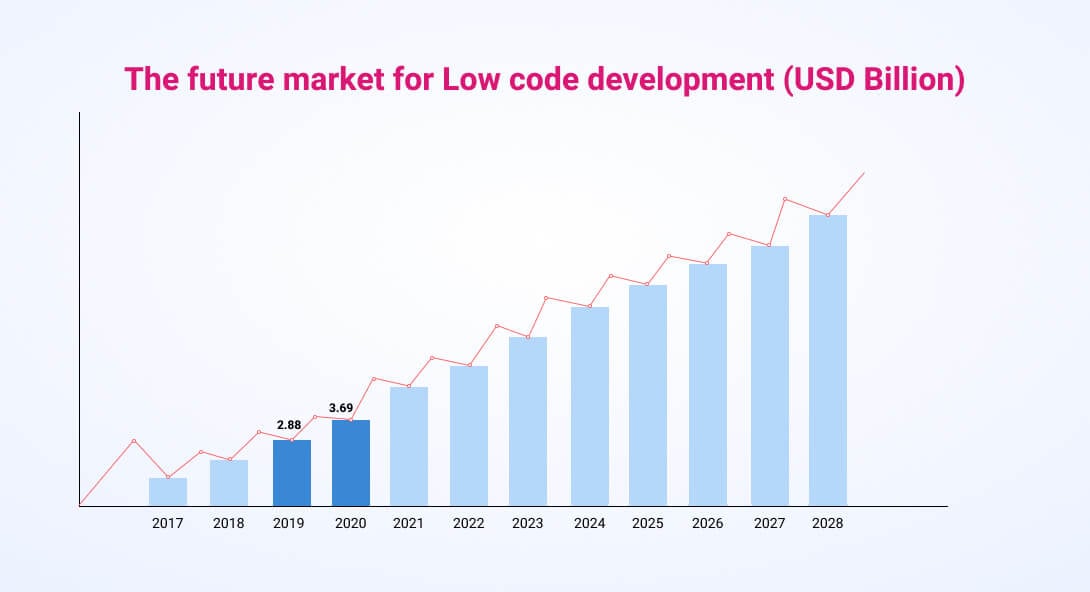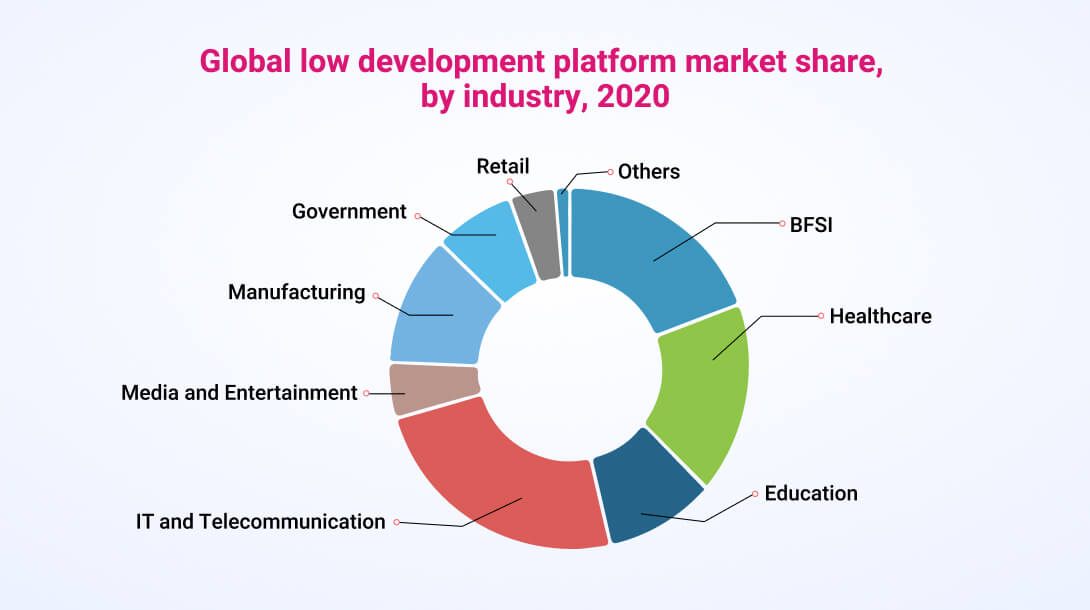-
An Overview of Low Code Platforms
-
What is Low Code Development?
-
What are Low Code Development Platforms?
- Types of Low-Code Development Platforms
- 10 Low Code Development Platforms for 2024-2025
-
The Future Market for Low-Code Development
-
Difference Between Low-code & No-code Development
- Features of Low Code Development
-
Take Away on Low Code Development Platforms
- Faqs
An Overview of Low Code Platforms
Traditional application development has changed as the need for the business world is changing. Low Code platform development has been here for a while. It is a software development approach where developers develop applications in a graphical interface, making less coding and automating the process. Such platforms help create business applications in no time. Thanks to the digital revolution, businesses are looking for much more graphically enhanced and not-so-tedious development processes, and thus low code development has gained popularity.
Development teams can use these platforms to create apps for commodity functions quickly and then tweak them to provide even more value. They can also spend more time developing custom apps or addressing initiatives that provide distinguishing value to their organizations.
Instead of writing extended, complex code and syntax, low-code developers with minimum programming knowledge can drag and drop visual models to create complete applications with modern user interfaces, integrations, data, and logic. This results in organizations creating apps faster.
What is Low Code Development?
Low Code is a development method to visually make the code look less cluttered, improve the text visually, and automate the development process. Low code development can be implemented in various ways without falling into large coding, manual programming, or testing processes. Businesses can leverage various benefits from low code development and embrace digital transformation in order to stay ahead of the competition.
The idea behind Low code development is to make app development easy without needing technical expertise. This frees up your technical resources who can engage in complex development processes. Low code development is considered a Rapid action development (RAD) approach. Due to automation, low-code users can concentrate on the differentiator rather than the common denominator of programming. Low code is a happy medium between manual coding and no code.
Some popular use cases of Low code development are mobile app development, enterprise app development, Customer experience apps, business process management software, automation, efficiency apps, cloud-based next-generation technologies, and more.
What are Low Code Development Platforms?
Low-code development platforms offer integrated development environments(IDE) that enable businesses to develop software quickly with minimal coding, reducing the need for extensive coding. These platforms include features, base-level code, scripts, and integrations that allow businesses to prototype, build, and scale applications without building complex structures.
Dedicated developers or personnel with less programming knowledge can use these tools to practice rapid application development with customized workflows and functionality. Some applications are targeted toward developers and require coding for functionality, whereas others offer design element libraries. Many products can read data from databases or spreadsheets and quickly generate applications to access and manage data.
Low code development is slightly different from no code development as they focus on greater functionality with customized code. Whereas some no-code development platforms are code extensible. Low-code platforms feature code customization as a primary function rather than a mandatory solution. Some of the benefits businesses can gain from adapting Low code development are:
- Increased productivity
- Time-saving
- Cost efficiency
- Added flexibility to system development
Types of Low-Code Development Platforms
Low-code development platforms are classified depending on their use. The classification is done as follows:
General Purpose Apps
As the name suggests, general-purpose low-code development platforms can develop and deploy applications anywhere. The platforms are capable of developing any type of application. It develops as per the requirements.
Process
These platforms handle application development for business processes such as workflow management, the development of apps that integrate with other applications, and more. It is also known as Low code business process management.
Request Handling
They are similar to process management platforms but at a lower level. As they only assist per the requests received. In a way, they fix requests and handle processes. Compared to other platforms these are less capable as they work only per request.
Database applications
Database application platforms are limited to data systems only. Database low-code platforms are ideal if you have a large amount of data to feed into a system but only have a little time to devote to the task.
Mobile application development platforms
MADP helps developers to develop, code, test and deploy mobile applications. These low-code development tools assist in developing applications for various platforms.
10 Low Code Development Platforms for 2024-2025
- Appian
- Mendix
- OutSystems
- Quickbase
- Zoho Creator
- Salesforce Lightning
- Microsoft Power Apps
- Nintex
- Application Express (APEX)
- Kissflow
1. Appian
- You can create solutions for your businesses using our low-code development platform.
- It supports low code as well as automates the development process.
- Appian ensures cost-effective app development.
- It helps you streamline your workflow as well as resources.
2. Mendix
- Mendix offers low-code software platform tools for testing, building, and deploying applications.
- It helps build cross-platform apps for all users, devices, and platforms.
- It can also extend, migrate and replace your existing systems.
- The platform relies on model-driven engineering (MDE)
3. OutSystems
- OutSystems is an omnichannel low-code platform, meaning businesses can create applications for various mediums.
- It has some of the best features, like Real-time performance dashboards, robust security, and more.
- All of this, along with rapid low-code application development.
4. Quickbase
- Quickbase is a low-code development platform specially designed for managing workflows.
- Especially suited for reforming operations.
- The platform’s strong assets are its prebuilt marketplace and useful third-party integrations.
5. Zoho Creator
- Zoho Creator is considered the best customer relationship management (CRM) tool.
- It is a Low code development platform with intuitive visual features.
6. Salesforce Lightning
- Salesforce Lightning is a framework for developing component-based applications.
- Well known for features such as interactive tabs, homepage components, assistance, and more.
7. Microsoft Power Apps
- With the help of Microsoft PowerApps, you may rapidly and easily construct unique business applications.
- The service’s functionality is impressive because it includes prebuilt artificial intelligence components.
- A prominent feature is it has 200 connectors to integrate disparate data and systems
8. Nintex
- Nintex is a process management platform and workflow automation requiring no coding.
- Its best features are Access Controls, Alerts, Approval Process Control, Archiving & Retention, Audit Trail, and Automated Routing.
- Business users up to the enterprise level can fully automate workflow and content processes with Nintex
- Workflow, allowing all employees and shareholders to connect, collaborate, and work more efficiently.
9. Application Express (APEX)
- APEX can help you build complex web applications that can be used in most modern web browsers.
- A low code development environment used to build scalable and secure enterprise apps.
- Developers can use APEX to quickly create and deploy compelling apps that solve real-world problems and provide immediate value.
- Involved with multi-faceted applications, APEX minimizes the complexity of applications.
10. Kissflow
- Create simple or complex workflows with parallel branches and conditional tasks in no time.
- Kissflow promotes itself as a ‘unified digital workplace.’
- Its primary tasks include workflow and process management.
- One of Kissflow’s biggest features is a rule-based model that eliminates the need for custom coding.
- It allows you to add conditions to tailor your workflow.
The Future Market for Low-Code Development
In the upcoming years, it is predicted that the global market for low-code development would expand. A crucial tool for the digital transition is the low code platform. By giving the development teams more authority, it aids in the reduction of resource expenses.
According to a Fortune Business Insights report, the low code development market is expanding and expected to continue growing in the coming years.


Difference Between Low-code & No-code Development
These pointers will assist you in determining how low code development benefits enterprises over traditional development methods.
| Differences | Low-code | No-code |
| Target users | Used by professional developers to avoid duplication of code, create more space, and add various advanced features to the application. | Businesses own them with vast domain knowledge but fewer coding skills. Also, suitable for non-technical teams. |
| Use cases | Best suited for enterprise apps that require huge business logic. Also, low code-generated apps are much better for those that need to be integrated with external APIs and multiple data sources. | Works well with frontend apps that work well with drag-and-drop features. This helps get rid of repetitive, monotonous tasks. |
| Speed | The application development and deployment will take time as it requires programming knowledge and onboarding of the team. Definitely faster than the traditional way of application development. | No code development is comparatively faster as it has drag-and-drop features. Testing becomes easy and quick as there are fewer manual inputs. |
| Open vs. closed systems | It is an open system whose functionalities can be increased by extended code, which makes it more flexible and reusable. | No code is a closed system, so it gets limited as it can be extended with only templated feature sets. |
| IT risk | The risks are less as the development process and the applications are still under the governance of IT professionals. | The more the process gets automated, the riskier it becomes as there is zero involvement of IT teams, and it needs to be monitored timely. |
| Architectural Range | Low code development wins in this feature as it has to get support from scalability and cross-platform development. This makes its implementation much wider and more frequent. | Comparatively, no code has less prospect of integrating with other systems or platforms, which reduces its ability to be upgraded and makes its use cases less. |
Features of Low Code Development
Low code allows developers to create applications with automation, resulting in faster time-to-launch. If you are looking to hire mobile app developers or any app development, let’s know how low code development can benefit your business. Some of the commendable features Low code development offers, which make it more in demand, are:
Quick mobility
Create one and keep reusing it everywhere. Applications developed in the current times must include cross-platform functionality in their design. With low-code development, everything should happen automatically, without extra effort, coding, or resources.
Declarative Tools
Declarative tools are implemented in low-code software via visual models and business rules. By eliminating the need to write custom code for these, future changes or additions are made more manageable, and development times are shortened.
Secures and scalable
Along with benefits, Low code development also has its downsides. Mainly when we talk about its security and scalability, low code development was earlier used for small and less critical applications. However, now it needs to be enterprise-level. The right platform has all the necessary security certifications and proven experience with large-scale initiatives.
Take Away on Low Code Development Platforms
Many low-code development platforms serve different purposes and users. Before considering any Low code development platform, one must know their project requirements. Finding the right low-code platform for your company can be challenging. Only some platforms have the features and functionality that your business requires. Some of its features, such as Visual modeling, reusable components, collaboration tools, scalable environments, data integration, and much more, help automate your software development process without much technical expertise.
Low code has helped many organizations of all levels all over the world with solutions that drive unprecedented business value. Dedicated developers at OpenXcell can help you leverage the best features of Low code development. Get in touch to know more…

Faqs
What does low-code mean?
Low code is a software approach with minimal coding to build and process applications. Low code mainly eliminates the requirement for writing custom code by using a variety of ready features such as UI components, scripts and integrations, solution blueprints, visual workflow automation tools, and more. Various platforms use Low code development, such as Appian, Squarespace, WordPress, Application Express (APEX), Weebly, etc.
When to use low-code platforms?
Various organizations design internal systems and automation workflows using low-code development platforms. Also, Low Code platforms can help you accelerate existing software as well.
What are Low Code and No Code?
Low Code and No Code are defined as visual development platforms that help build applications even for non-tech people. Users can build, test, manage, and deploy applications without traditional programming knowledge. Using a drag-and-drop interface, platforms that use low-code or no-code can develop ready-to-use code chunks that may function within preset parameters.
Why is low code the Future?
Low-code platforms enable users to create applications using an intuitive and simple design interface. This enables users to create apps without substantial programming or coding experience. Not only this, you can read on Guide to Low Code development which helps you know its benefits and why Low code Is the Future.
Who can use Low code applications?
Any companies looking to develop or accelerate their existing applications can use Low code development. Any developer, and also the ones with no programming knowledge, can work on Low code applications.
Which low-code platform is best?
There are plenty of low-code platforms available today. While selecting one, check for a rapid application development environment if you are looking for speed and agility. To name a few low-code platforms are:
1. Appian
2. Mendix
3. OutSystems
4. Quickbase
5. Zoho Creator









